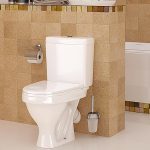Content
- 1 Metal pipes
- 2 Plastic pipes
- 3 Polyethylene pipes
- 4 What is the best way to use
Most plumbing works hide in walls. Pipe wiring was no exception. Not every material can be mounted in the thickness, because corrosion, strength and probability of emergency situations are taken into account. Which pipes are not suitable for internal wiring?

Metal pipes
About 10 years ago, metal pipes were used everywhere, but today their popularity is fading. This can be explained very simply: the metal is difficult to work and the assistance of the welder during installation is required. Metal pipes are high, but this does not guarantee their protection against corrosion, scale and deposits of salts, heavy metals on the inner wall.


Plastic pipes
In the context of such pipes, they look like a combination of many layers of metal and plastic. Due to the first component, the pipe body acquires plasticity and strength, and due to the second, the desired shape and flexibility. The layers are bonded together on a strong adhesive. Despite the many advantages, namely: low cost, corrosion resistance, durability, lack the need for cleaning internal surfaces from deposits and ease of installation, plastic pipes are not suitable for hidden wiring.

The minuses include the periodic need to tighten threaded connections, which is not realized if the pipes are hidden in the wall. Also, the connecting elements of such pipes have a rather high price. At the same time, the strength of pipes and threaded connections is low.

Polyethylene pipes
There are two types of pipes made of polyethylene: low pressure and cross-linked. The former do not withstand temperatures above 40 degrees and are used for cold water supply from the well to the house. The second are more versatile, are used for hot water, but have too high a price. They are not suitable for covert cabling, as it is designed for communications in the ground.


What is the best way to use
For hidden cabling, polypropylene pipes are most often used, which are the best option for this type of work. Among them distinguish between reinforced and unreinforced varieties. The former are used for cold water, and the latter for hot. Pipes are reinforced with aluminum, fiberglass or other materials.

Polypropylene pipes have many advantages: durability of use, easy installation using special welding machine, reliable connections, strength, the material withstands pressure of 20 atmospheres, corrosion resistance and freezing.

When installing a hidden wiring of polypropylene pipes reinforced with aluminum or kapron thread, it is necessary to lay insulation in the strobes. This is due to the fact that with such reinforcement, the pipes retain a high degree of change from the action of high temperatures.

-
 What signs indicate a fake building materials
What signs indicate a fake building materials
-
 Impressive new finishes
Impressive new finishes
-
 Bamboo wallpapers: types, advantages, combinations
Bamboo wallpapers: types, advantages, combinations
-
 Silk-screen wallpaper for walls
Silk-screen wallpaper for walls
-
 Sandwich panels: economy, practicality, attractiveness
Sandwich panels: economy, practicality, attractiveness
-
 What signs indicate laminate flooring errors and how to fix it
What signs indicate laminate flooring errors and how to fix it
-
 Why very often experienced people use polystyrene for insulation
Why very often experienced people use polystyrene for insulation
-
 What pipes are not suitable for laying a cold pipeline
What pipes are not suitable for laying a cold pipeline
-
 Which toilet tank spends a lot of water and poorly performs its function
Which toilet tank spends a lot of water and poorly performs its function
-
 Is OSB cooker really dangerous and can it be used indoors
Is OSB cooker really dangerous and can it be used indoors
-
 Silk-screen wallpaper for walls
Silk-screen wallpaper for walls
-
 What roof will have to be repaired after 5 years of operation
What roof will have to be repaired after 5 years of operation
New publications are published daily on our channel in Yandex. Zen
Go to Yandex. Zen


